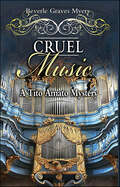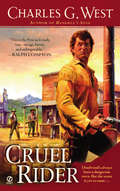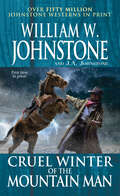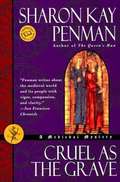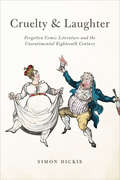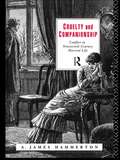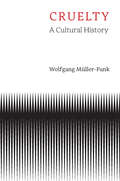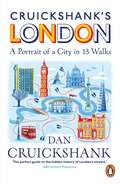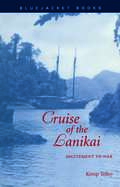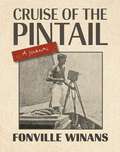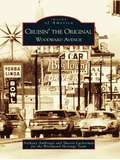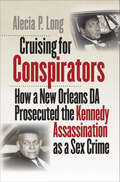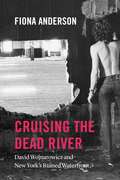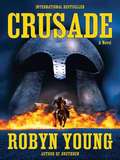- Table View
- List View
Cruel Music (Tito Amato Series #0)
by Beverle Graves MyersTito Amato returns from an operatic tour expecting to relax with his family. Instead he finds his merchant brother Alessandro imprisoned on a trumped-up smuggling charge, a capital crime in 1740 Venice. The senator who controls Alessandro's fate is determined to have a Venetian as the next pope. He forces Tito to Rome to sing at the villa of a powerful, music-loving cardinal who will control the coming papal election.Spying as he serenades Cardinal Fabiani and his guests, Tito peers into the dark mirror of Roman politics. Pope Clement XII is sinking fast, and two candidates emerge as leading contenders for St. Peter's throne. Will Fabiani support the highborn Venetian whose secret passion is tinkering with electrical experiments? Or the humble cardinal with the gift of healing and a mysterious past?The discovery of a beautiful corpse in Fabiani's garden complicates Tito's mission. Fabiani believes that a member of his household killed the young maid in a fit of madness, but Tito follows clues that indicate a more complex motive, assisted by his irrepressible manservant Benito and Englishman Gussie Rumbolt. From the heights of the Janiculum Hill to the muddy waters of the Tiber, from a cozy Trastevere cookshop to the chilly corridors of the Quirinal Palace, the trio wrestles with events that could change the course of history. Can Tito stop the killer and affect the election before Pope Clement takes his last breath? Or will Alessandro face the scaffold?
Cruel Rider
by Charles G. WestBill Pike wasn't born a bad man. It took years of hardscrabble living and a cruel, violent upbringing to forge Pike into what he has become: a savage killer with no mercy. Now his wife has up and run off on him, and he's not about to let her go without a reckoning. When pretty Polly Pike asks mountain man Jordan Gray to guide her to the Black Hills, he isn't happy about taking the job, and he finds nothing but problems when they hit Deadwood.
Cruel Winter of the Mountain Man (Mountain Man #50)
by William W. Johnstone J.A. JohnstoneThe latest action-packed installment in the national bestselling Western authors William W. Johnstone and J.A. Johnstone&’s long-running Mountain Man historical series. The 50th Book in the Bestselling Mountain Man Series!A cold day in hell descends upon Texas when mountain man sharpshooter Smoke Jensen pins on a tin star to tackle a wild bunch of bloodthirsty outlaws in this gun-blazing novel from national bestselling authors William W. Johnstone and J.A. Johnstone.Johnstone Country. A Glorious Land. Jonas Madigan is dying. He spent his life taming towns and upholding justice across the west with no regrets. Along the way, Madigan took the measure of good men like Smoke Jensen, who has traveled to Salt Lick, Texas to pay his respects to the lawman. But when bandits gun down the small town&’s current marshal—and Smoke sends the killers to Boot Hill—Madigan asks his friend to wear the badge and keep the peace until a permanent replacement is sworn in. Turns out the bandits were members of Bishop&’s Mauraders, a twenty-man gang of trigger-happy thieves led by the vicious and venomous Snake Bishop—and they&’ve set their sights on Salt Lick. They&’re due to arrive at the same time as a monstrous blizzard that&’s covering up the countryside. Now, it&’s up to Smoke to turn the townspeople into a posse to defend their lives and land from both mother nature and man&’s worst nature . . . Live Free. Read Hard.
Cruel World: The Children of Europe in the Nazi Web
by Lynn H. NicholasTo be a child in mid-twentieth-century Europe was to be not a person but an object, available for use in the service of the totalitarian state. Very soon after Adolf Hitler came to power, policies of eugenic selection and euthanasia began to weed ill or disabled children out of the New Order by poison, gas, and starvation. Defect-free "good blood" children were subjected to an "education" based on racism, propaganda, and the glorification of the Führer, and were deliberately deprived of free time that would allow independent thought or action. Once the war began, "Nordic"-looking children were kidnapped from families in the conquered lands and subjected to "Germanization." Meanwhile, hundreds of thousands of "bad blood" children--Jews, Gypsies, Poles, Ukrainians, Russians(were separated from their families and condemned to forced migration, slave labor, sadistic experiments, starvation, and mass execution. At the end of the war, uprooted children of every origin wandered the bombed-out cities and countryside, some having been taken from home at such a young age that they did not know where they had come from or even their own names. Millions surged into and out of DP camps, exploited by political and religious groups, while the Allies and the fledgling United Nations tried mightily to put families back together and to find new homes for the orphans.All the riveting narrative skill and impeccable scholarship that distinguished Lynn Nicholas's first book, The Rape of Europa (winner of the National Book Critics Circle Award for nonfiction), are present in her study of these terrible crimes against humanity. To research this story she has delved into the governmental and military archives of many nations, and has interviewed countless individuals. She shows the relationship of the deadly Nazi policies to the brutal tactics used in the USSR in the 1930s and to their rehearsal in the Spanish Civil War, and vividly describes the abject failure of Hitler's campaign to plant Germanizing colonies in the conquered nations. She gives us the stories of survivors of ghastly war-spawned famines(in Greece and Russia in the 1940s, Holland in the "Hunger Winter" of 1945, and Berlin in the Airlift year of 1949(and of British, French, and Dutch children who were evacuated to the countryside; boys and girls sent alone from Europe to England on the Kindertransports; the teenaged soldiers of the Reich; the small veterans of the quarries, the factories, and the camps as well as those who survived in lonely hiding.In Cruel World Lynn Nicholas shows us clearly, and with passionate empathy for the innocent victims, the crimes against children that inevitably result when ideology overwhelms humanity. This powerful book, as it recounts the waking nightmare that enmeshed the lives of Europe's boys and girls, bears witness to our own responsibility to the children of the twenty-first century.From the Hardcover edition.
Cruel and Unusual: The Culture of Punishment in America
by Anne-Marie CusacThe statistics are startling. Since 1973, America's imprisonment rate has multiplied over five times to become the highest in the world. More than two million inmates reside in state and federal prisons. What does this say about our attitudes toward criminals and punishment? What does it say about us? This book explores the cultural evolution of punishment practices in the United States. Anne-Marie Cusac first looks at punishment in the nation's early days, when Americans repudiated Old World cruelty toward criminals and emphasized rehabilitation over retribution. This attitude persisted for some 200 years, but in recent decades we have abandoned it, Cusac shows. She discusses the dramatic rise in the use of torture and restraint, corporal and capital punishment, and punitive physical pain. And she links this new climate of punishment to shifts in other aspects of American culture, including changes in dominant religious beliefs, child-rearing practices, politics, television shows, movies, and more. America now punishes harder and longer and with methods we would have rejected as cruel and unusual not long ago. These changes are profound, their impact affects all our lives, and we have yet to understand the full consequences.
Cruel as the Grave: A Medieval Mystery
by Sharon Kay PenmanApril 1153. The murder of a Welsh peddler's daughter seems small compared to England's King Richard Lionheart in a German prison. Justin is torn between mediating a truce with Richard and his brother John, and investigating the murder.
Cruelty & Laughter: Forgotten Comic Literature and the Unsentimental Eighteenth Century
by Simon DickieEighteenth-century British culture is often seen as polite and sentimental—the creation of an emerging middle class. Simon Dickie disputes these assumptions in Cruelty and Laughter, a wildly enjoyable but shocking plunge into the forgotten comic literature of the age. Beneath the surface of Enlightenment civility, Dickie uncovers a rich vein of cruel humor that forces us to recognize just how slowly ordinary human sufferings became worthy of sympathy.Delving into an enormous archive of comic novels, jestbooks, farces, variety shows, and cartoons, Dickie finds a vast repository of jokes about cripples, blind men, rape, and wife-beating. Epigrams about syphilis and scurvy sit alongside one-act comedies about hunchbacks in love. He shows us that everyone—rich and poor, women as well as men—laughed along. In the process, Dickie also expands our understanding of many of the century’s major authors, including Samuel Richardson, Lady Mary Wortley Montagu, Tobias Smollett, Frances Burney, and Jane Austen. He devotes particular attention to Henry Fielding’s Joseph Andrews, a novel that reflects repeatedly on the limits of compassion and the ethical problems of laughter. Cruelty and Laughter is an engaging, far-reaching study of the other side of culture in eighteenth-century Britain.
Cruelty and Civilization: The Roman Games
by Roland AuguetRoland Auguet examines the Roman taste for blood and considers what the games, that strange combination of Cruelty and Civilization, reveal about the Roman mentality. He shows how the great spectacles became a part of city life - they were awaited with impatience, everyone discussed them, some applauded the action in the arena, while others booed frantically.This book provides an exciting history of gladiators, chariot racing and other games as well as an investigation of their function and significance within society. It is essential reading for anyone who is interested in the Romans' violent form of entertainment.
Cruelty and Companionship: Conflict in Nineteenth Century Married Life
by A. James HammertonCruelty and Companionship is an account of the intimate but darker sides of marriage in Victorian and Edwardian England. Hammerton draws upon previously unpublished material from the records of the divorce court and magistrates' courts to challenge many popular views about changing family patterns. His findings open a rare window onto the sexual politics of everyday life and the routine tensions which conditioned marriage in middle and working class families. Using contemporary evidence ranging from prescriptive texts and public debate to autobiography and fiction, Hammerton examines the intense public scrutiny which accompanied the routine exposure of marital breakdown, and charts a growing critique of men's behaviour in marriage which increasingly demanded regulation and reform. The critical discourse which resulted, ranging from paternalist to feminist, casts new light on the origins and trajectory of nineteenth century feminism, legal change and our understanding of the changing expression of masculinity.
Cruelty: A Cultural History
by Wolfgang Müller-FunkIn a humane world, cruelty should not exist, and yet it has been a feature of our societies since time immemorial. From individual acts of cruelty to systematic torture and mass murder, cruelty has been humanity’s constant companion, attesting to a darker side of human nature. Cruelty involves the use of violence but it is more than this, since it is organized and calculated; its intention is to inflict pain and suffering on others, even to destroy the other. Cruelty is perhaps the ultimate form of violence in which the extermination of the other is staged as a threat in order to make others compliant or instil in them the fear of death.In this wide-ranging cultural history, Wolfgang Müller-Funk examines the ways in which different thinkers and authors – from Herodotus to Nietzsche, from Seneca to Musil and Koestler – have conceptualized and tried to make sense of a phenomenon we would prefer to ignore. He seeks to unveil the conditions under which an economy of cruelty emerges, in which violence is calculated and becomes a quasi-natural matter of course. The economy of cruelty involves the efficient use of means to pursue irrational goals. It also involves discourses and narrative patterns that legitimize organized violence and neutralize emotions, such as empathy and compassion, that would restrain or obstruct the pursuit of cruelty.This disturbing inquiry into the nature of cruelty and its role in human culture will be of interest to students and scholars throughout the humanities and to a wide general readership.
Cruickshank’s London: A Portrait of a City in 13 Walks
by Dan Cruickshank'The perfect guide to the hidden history of London's streets.' BBC History MagazineIn Cruickshank's London, Britain's favourite architectural historian describes thirteen walks through one of the greatest cities on earth. From the mysterious Anglo-Saxon origins of Hampstead Heath, via Christopher Wren's magisterial City churches, to the industrial bustle of Victorian Bermondsey, each walk explores a crucial moment in our history - and reveals how it helped forge the modern city. Along the way, Cruickshank peppers the book with vivid photographs, sketches and maps, so you can immediately follow in his footsteps.Every street in London contains a story. This book invites you to hear them.___'An inspiringly illustrated guide to walks across London . . . It proves how much we can miss if we don't pay close attention to our surroundings.' Country Life'All power to Cruickshank and his intrepid and knowledgeable kind. We need them.' Times Literary Supplement
Cruise Ships: The Small Scale Fleet
by Peter C. SmithPeter C. Smith presents us here with the second release in his visually splendid Cruise Ships series. Whilst his first book concerned itself with the large-scale ships currently cruising through our seas (those weighing 40,000 GT and more) this volume focusses on the other end of the market; the ships that weigh in at less than 40,000 GT, but which are often much more stylish and aesthetically pleasing than their larger-scale counterparts. The elegant interiors and luxurious features on display in today's vast fleet of cruise liners remain unrecorded in all but holiday brochures. This book carries on in the tradition of Peter's last release, giving a complete overview of the best of these ships, the cream of the crop, so to speak.Each colour profile includes external and interior views of the featured ship. Details of the design, building and service history of each vessel are provided with vital statistics of the ship and its facilities.This is a book of reference for maritime enthusiasts, would-be holiday cruisers and those who have been passengers. It serves as an impressive visual tribute to the best of the smaller scale fleet currently cruising globally.As seen in the Bedford Times & Citizen.
Cruise Ships: The Small Scale Fleet
by Peter C. SmithPeter C. Smith presents us here with the second release in his visually splendid Cruise Ships series. Whilst his first book concerned itself with the large-scale ships currently cruising through our seas (those weighing 40,000 GT and more) this volume focusses on the other end of the market; the ships that weigh in at less than 40,000 GT, but which are often much more stylish and aesthetically pleasing than their larger-scale counterparts. The elegant interiors and luxurious features on display in today's vast fleet of cruise liners remain unrecorded in all but holiday brochures. This book carries on in the tradition of Peter's last release, giving a complete overview of the best of these ships, the cream of the crop, so to speak.Each colour profile includes external and interior views of the featured ship. Details of the design, building and service history of each vessel are provided with vital statistics of the ship and its facilities.This is a book of reference for maritime enthusiasts, would-be holiday cruisers and those who have been passengers. It serves as an impressive visual tribute to the best of the smaller scale fleet currently cruising globally.As seen in the Bedford Times & Citizen.
Cruise of the Lanikai
by Kemp TolleyIn early December 1941 in the Philippines, a young Navy ensign named Kemp Tolley was given his first ship command, an old 76-foot schooner that had once served as a movie prop in John Ford's "The Hurricane." Crewed mostly by Filipinos who did not speak English and armed with a cannon that had last seen service in the Spanish-American War, the Lanikai was under top-secret presidential orders to sail south into waters where the Japanese fleet was thought to be. Ostensibly the crew was to spy on Japanese naval movements, but to Tolley it was clear that their mission was to create an incident that would provoke war.Events overtook the plan, however, when Pearl Harbor was bombed before the Lanikai could get underway. When Bataan and Corregidor fell, she was ordered to set sail for Australia and became one of the few U.S. naval vessels to escape the Philippines. In this book Tolley tells the saga of her great adventure during these grim, early days of the war and makes history come alive as he regales the reader with details of the operation and an explanation of President Roosevelt's order. Tolley's description of their escape in Japanese warship-infested waters ranks with the best of sea tales, and few will be able to forget the Lanikai's 4,000-mile, three-month odyssey.
Cruise of the Pintail: A Journal (The Hill Collection: Holdings of the LSU Libraries)
by Robert L. Winans James R. TurnerIn 1932 a young Fonville Winans (1911--1992) left his home in Fort Worth and set out on the waterways of south Louisiana searching for adventure and fortune. This journal recounts, in his own words, how the now-renowned photographer and his two friends -- first mate Bob Owen and second mate Don Horridge -- ventured onto untamed Louisiana waters aboard a leaking, rudderless sailboat, the Pintail. Fonville was shooting footage for a movie that he felt certain would make them rich and famous, telling the story of subtropical south Louisiana's remote coastal landscapes and its curious people. The project was ambitious and risky -- just the right combination for three young Texans with hopes of stardom. Developing his photographic skill, Fonville traveled during the summers of 1932 and 1934 to swamps, barrier islands, and reefs, from Grand Isle to New Orleans to the Atchafalaya, making friends and taking pictures. The journal, in effect, layers Fonville's unique voice over his now-iconic visual record of moving images and stills. Robert L. Winans selected more than one hundred photos to accompany his father's diary entries, offering a fascinating inner look at Fonville Winans's world.
Cruisin' the Original Woodward Avenue (Images of America)
by Anthony Ambrogio Woodward Heritage Team Sharon LuckermanIn the 1950s, cruising swept the nation. American street became impromptu racetracks as soon as the police turned their backs. Young people piled into friends' cars and cruised their main streets with a new sense of freedom. Pent-up desires after the hardships of World War II plus a booming economy fueled a car-buying frenzy. To lure buyers to their particular makes and models, automobile companies targeted the youth market by focusing on design and performance. No place was that more relevant than on metro Detroit's Woodward Avenue, the city's number-one cruising destination and home of the world's automobile industry. Barely 50 years earlier, Henry Ford rolled his first Model T off the assembly line at Piquette and Woodward, just south of where cruisers, dragsters, and automobile engineers ignited each other's excitement over cars. This unique relationship extended into the muscle car era of the 1960s, as Woodward Avenue continued to reflect the triumphs and downturns of the industry that made Detroit known throughout the world.
Cruising for Conspirators: How a New Orleans DA Prosecuted the Kennedy Assassination as a Sex Crime (Boundless South)
by Alecia P. LongNew Orleans district attorney Jim Garrison's decision to arrest Clay Shaw on March 1, 1967, set off a chain of events that culminated in the only prosecution undertaken in the assassination of John F. Kennedy. In the decades since Garrison captured headlines with this high-profile legal spectacle, historians, conspiracy advocates, and Hollywood directors alike have fixated on how a New Orleans–based assassination conspiracy might have worked. Cruising for Conspirators settles the debate for good, conclusively showing that the Shaw prosecution was not based in fact but was a product of the criminal justice system's long-standing preoccupation with homosexuality. Tapping into the public's willingness to take seriously conspiratorial explanations of the Kennedy assassination, Garrison drew on the copious files the New Orleans police had accumulated as they surveilled, harassed, and arrested increasingly large numbers of gay men in the early 1960s. He blended unfounded accusations with homophobia to produce a salacious story of a New Orleans-based scheme to assassinate JFK that would become a national phenomenon. At once a dramatic courtroom narrative and a deeper meditation on the enduring power of homophobia, Cruising for Conspirators shows how the same dynamics that promoted Garrison's unjust prosecution continue to inform conspiratorial thinking to this day.
Cruising in Montgomery and Berks Counties (Images of Modern America)
by Tina M. KissingerMontgomery and Berks Counties have been central to the car industry for decades, employing residents of the cities and surrounding small towns. Pottstown first came to be known as the cruising capital of the East Coast in the 1950s and held on to the title for many years. In the 1960s, hundreds would line the sidewalks to watch the hot rods and classic cars cruise down High Street. Among the circuit favorites were the Tropical Treat, Hilltop Drive-In, and Dempsey Diner. Lansdale also attracted automobile enthusiasts who enjoyed "cruising the Dale." In 1962, the Maple Grove Raceway, a quarter-mile strip in Mohnton, opened and became home to the popular Super Chevy Weekend, hosting great drivers like Fred Spezio, Ken Hall, and John Johnson. The Grandview Speedway and the Reading Fairgrounds Speedway also emerged, attracting even more auto racing enthusiasts from around the area. Today, longtime residents enjoy reminiscing their beloved cruising pastime, with many belonging to historical automotive clubs.
Cruising the Dead River: David Wojnarowicz and New York's Ruined Waterfront
by Fiona AndersonIn the 1970s, Manhattan’s west side waterfront was a forgotten zone of abandoned warehouses and piers. Though many saw only blight, the derelict neighborhood was alive with queer people forging new intimacies through cruising. Alongside the piers’ sexual and social worlds, artists produced work attesting to the radical transformations taking place in New York. Artist and writer David Wojnarowicz was right in the heart of it, documenting his experiences in journal entries, poems, photographs, films, and large-scale, site-specific projects. In Cruising the Dead River, Fiona Anderson draws on Wojnarowicz’s work to explore the key role the abandoned landscape played in this explosion of queer culture. Anderson examines how the riverfront’s ruined buildings assumed a powerful erotic role and gave the area a distinct identity. By telling the story of the piers as gentrification swept New York and before the AIDS crisis, Anderson unearths the buried histories of violence, regeneration, and LGBTQ activism that developed in and around the cruising scene.
Cruisy, Sleepy, Melancholy: Sexual Disorientation in the Films of Tsai Ming-liang
by Nicholas de VilliersA brilliant approach to the queerness of one of Taiwan&’s greatest auteurs A critical figure in queer Sinophone cinema—and the first director ever commissioned to create a film for the permanent collection of the Louvre—Tsai Ming-liang is a major force in Taiwan cinema and global moving image art. Cruisy, Sleepy, Melancholy offers a fascinating, systematic method for analyzing the queerness of Tsai&’s films.Nicholas de Villiers argues that Tsai expands and revises the notion of queerness by engaging with the sexuality of characters who are migrants, tourists, diasporic, or otherwise displaced. Through their lack of fixed identities, these characters offer a clear challenge to the binary division between heterosexuality and homosexuality, as well as the Orientalist binary division of Asia versus the West. Ultimately, de Villiers explores how Tsai&’s films help us understand queerness in terms of spatial, temporal, and sexual disorientation.Conceiving of Tsai&’s cinema as an intertextual network, Cruisy, Sleepy, Melancholy makes an important addition to scholarly work on Tsai in English. It draws on extensive interviews with the director, while also offering a complete reappraisal of Tsai&’s body of work. Contributing to queer film theory and the aesthetics of displacement, Cruisy, Sleepy, Melancholy reveals striking connections between sexuality, space, and cinema.
Crumbs from the Round Table: A Feast for Epicures
by Joseph BarberPublished in 1866 in New York, Crumbs from the Round Table is a collection of epicurean poetry, editorials, and articles from a culinary critic of the day, Joseph Barber. In his book, Barber describes himself as writing &“that which he knows, a fact which will become apparent to the reader of these sketches&” and showcases his &“foodie&” skills with works such as &“Epigastric Poetry,&” &“A Few Words about Puddings,&” &“The Fruits of June,&” and &“Savory Stanzas for November.&” With a humorous and entertaining flair, Crumbs from the Round Table provides not only a fascinating look at mid-19th century culinary criticism and thought but also an insightful collection highlighting the wit and social attitudes of the time. This edition of Crumbs from the Round Table was reproduced by permission from the volume in the collection of the American Antiquarian Society, Worcester, Massachusetts. Founded in 1812 by Isaiah Thomas, a Revolutionary War patriot and successful printer and publisher, the society is a research library documenting the lives of Americans from the colonial era through 1876. The society collects, preserves, and makes available as complete a record as possible of the printed materials from the early American experience. The cookbook collection includes approximately 1,100 volumes.
Crumbs from the Round Table: A Feast for Epicures
by Joseph BarberPublished in 1866 in New York, Crumbs from the Round Table is a collection of epicurean poetry, editorials, and articles from a culinary critic of the day, Joseph Barber. In his book, Barber describes himself as writing &“that which he knows, a fact which will become apparent to the reader of these sketches&” and showcases his &“foodie&” skills with works such as &“Epigastric Poetry,&” &“A Few Words about Puddings,&” &“The Fruits of June,&” and &“Savory Stanzas for November.&” With a humorous and entertaining flair, Crumbs from the Round Table provides not only a fascinating look at mid-19th century culinary criticism and thought but also an insightful collection highlighting the wit and social attitudes of the time. This edition of Crumbs from the Round Table was reproduced by permission from the volume in the collection of the American Antiquarian Society, Worcester, Massachusetts. Founded in 1812 by Isaiah Thomas, a Revolutionary War patriot and successful printer and publisher, the society is a research library documenting the lives of Americans from the colonial era through 1876. The society collects, preserves, and makes available as complete a record as possible of the printed materials from the early American experience. The cookbook collection includes approximately 1,100 volumes.
Crumps and Camouflets: Australian Tunnelling Companies on the Western Front
by Damien FinlaysonBelow the shattered ground that separated the British and German infantry on the Western Front in World War I, an unseen and largely unknown war was raging, fought by miners, 'tunnellers' as they were known. They knew at any moment their lives could be extinguished without warning by hundreds of tonnes of collapsed earth and debris.
Crunchyroll Essential Anime: Fan Favorites, Memorable Masterpieces, and Cult Classics
by Patrick Macias Samuel SattinAn insightful guide to the under-explored medium of anime, Crunchyroll's Essential Anime features 50 influential and unforgettable anime series and films that have left an undeniable impact on our culture. More than just a list of anime to watch, Essential Anime digs into the distinct stories of the creators and studios behind the making of these must-see anime titles, as well as the personal connections and importance they hold with anime fans around the world. With commentary on anime's history and lasting appeal, recommendation lists, and hundreds of stunning images, Crunchyroll's Essential Anime is an indispensable guide for anime lovers and fans, offering an entertaining and moving narrative about anime's true impact on pop culture.Ranging from classic and modern series and films this official guide will explore iconic and must-see: Feature films: Akira (1988), Princess Mononoke (1997), Millennium Actress (2001), Metropolis (2001), Tekkonkinkreet (2006), Sword of the Stranger (2007), Summer Wars (2009), and Your Name (2016) Series: Astro Boy (1963), Lupin the 3rd (1967), Macross (1982), Ranma 1/2 (1989), Neon Genesis Evangelion (1995), Dragon Ball Z (1989), Sailor Moon (1992), Revolutionary Girl Utena (1997), Pokémon (1997), One Piece (1999), K-On! (2007), Fullmetal Alchemist: Brotherhood (2009), Sword Art Online (2012), Yuri On Ice!!! (2016), My Hero Academia (2018), and Demon Slayer: Kimetsu no Yaiba (2019)And more!
Crusade
by Robyn YoungIt is 1274 and in the fortified city of Acre, the last major stronghold of the Crusaders in Palestine, an epic conflict is beginning. Will Campbell is a Templar Knight, trained for war, but as a member of the mysterious group known as the Brethren, he is also a man of peace. After years of bloodshed, the Brethren have helped to create a truce between the Christians and Muslims. But Will now fears they have been betrayed. King Edward of England has promised the Pope that he will lead a new Crusade, while in Acre itself, a ruthless cabal of Western merchants, profiteering from slaves and armaments, is plotting to reignite hostilities in the Holy Land. Meanwhile, in Egypt, Sultan Baybars is caught in a power struggle. His son and heir has become involved in the dangerous designs of the insidious soothsayer, Khadir. While Baybars wants to take on the mighty Mongol empire, Khadir and others want to destroy the Christians once and for all. As war looms, Will is torn between his oath as a Templar, his secret role in the Brethren and his duty to Elwen, the woman he loves but is forbidden to marry. He is caught at the centre of a web of deception and destruction, as he and all those around him rush headlong towards one of the most dramatic moments in history.
